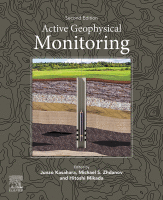Browse content
Table of contents
Actions for selected chapters
- Full text access
- Book chapterNo access
Index
Pages 605-617
About the book
Description
Active Geophysical Monitoring, Second Edition, presents a key method for studying time-evolving structures and states in the tectonically active Earth's lithosphere. Based on repeated time-lapse observations and interpretation of rock-induced changes in geophysical fields periodically excited by controlled sources, active geophysical monitoring can be applied to a variety of fields in geophysics, from exploration, to seismology and disaster mitigation. This revised edition presents the results of strategic systematic development and the application of new technologies. It demonstrates the impact of active monitoring on solid Earth geophysics, also delving into key topics, such as carbon capture and storage, geodesy, and new technological tools.
This book is an essential for graduate students, researchers and practitioners across geophysics.
Active Geophysical Monitoring, Second Edition, presents a key method for studying time-evolving structures and states in the tectonically active Earth's lithosphere. Based on repeated time-lapse observations and interpretation of rock-induced changes in geophysical fields periodically excited by controlled sources, active geophysical monitoring can be applied to a variety of fields in geophysics, from exploration, to seismology and disaster mitigation. This revised edition presents the results of strategic systematic development and the application of new technologies. It demonstrates the impact of active monitoring on solid Earth geophysics, also delving into key topics, such as carbon capture and storage, geodesy, and new technological tools.
This book is an essential for graduate students, researchers and practitioners across geophysics.
Key Features
- Outlines the general concepts of active geophysical monitoring with powerful seismic vibrators and MHD generators
- Provides historical background for previous studies of seismically active zones
- Covers the theory and technology of active monitoring, including signal processing, data analysis, novel approaches to numerical modeling, and interpretation
- Discusses case histories and presents the results of worldwide, regional active monitoring experiments
- Thoroughly updated to include recent developments, such as updates relating to carbon capture and storage, microgravity, InSAR technologies, geodesy, reservoir monitoring, seismic reflection, and more
- Outlines the general concepts of active geophysical monitoring with powerful seismic vibrators and MHD generators
- Provides historical background for previous studies of seismically active zones
- Covers the theory and technology of active monitoring, including signal processing, data analysis, novel approaches to numerical modeling, and interpretation
- Discusses case histories and presents the results of worldwide, regional active monitoring experiments
- Thoroughly updated to include recent developments, such as updates relating to carbon capture and storage, microgravity, InSAR technologies, geodesy, reservoir monitoring, seismic reflection, and more
Details
ISBN
978-0-08-102684-7
Language
English
Published
2020
Copyright
Copyright © 2020 Elsevier Ltd. All rights reserved.
Imprint
Elsevier
